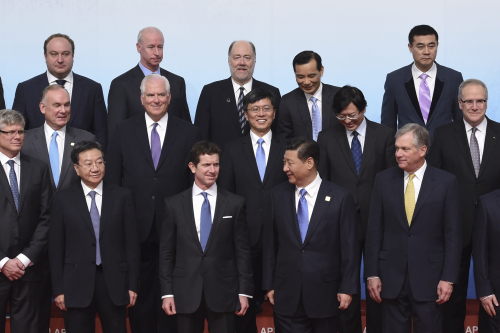|
 |
|
BRIDGE BUILDERS: Participants of the Asia-Pacific Economic Cooperation (APEC) CEO Summit pose for a group photo in Beijing on November 9, 2014 (LIAO PAN) |

When Chinese President Xi Jinping first unveiled the Chinese dream concept in 2012, some observers interpreted his idea as a vague attempt to foster unity among the Chinese people. Two years later, Xi's governing style has been widely recognized for making fruitful achievements in economic reform, anti-corruption and international relations. Few would still claim that the Chinese dream is empty rhetoric, as the reality behind the vision takes shape day by day.
The Chinese dream is not limited to the Chinese people themselves in isolation from the world. The Chinese leader envisions the further integration and in-depth cooperation of the global community as necessary conditions for achieving the Chinese dream in the modern era. In the past two years, President Xi has visited more than 30 countries covering five continents, stressing repeatedly through contact with local people that the Chinese dream "will not only benefit the Chinese people but also will benefit the people of the whole world."
A dream for the Asia-Pacific
China operates under several geopolitical identities. For one, it is a country of the Asia-Pacific--a region that is particularly important for Chinese diplomacy. The Chinese economy, now the second largest in the world, accounts for one fourth of the Asia-Pacific economy. Eight of China's top 10 trading partners are located in the region. When the late Chinese leader Deng Xiaoping adopted the reform and opening-up policy 36 years ago, Asia-Pacific countries including Japan, Thailand, Singapore and the United States were among Deng's first state visits due to their significance for China's economic expansion. The interconnection between the Chinese dream and the world also begins with the dynamic region.
In November 2014, when President Xi addressed the opening ceremony of the Asia-Pacific Economic Cooperation CEO Summit in Beijing, he called on regional countries to jointly build a future-oriented Asia-Pacific partnership, saying, "We are duty-bound to create and fulfill an Asia-Pacific dream for our people."
Xi further explained that the idea was to act in the spirit of the Asia-Pacific community out of a sense of shared destinies, following the trends of peace, development and mutually beneficial cooperation. It is about staying ahead of global development and making greater contributions to the well-being of mankind--a path to economic vibrancy, free trade and investment facilitation, better roads, and closer people-to-people exchanges.
Xi's Asia-Pacific dream is not simply a matter of public diplomacy; rather, it is a systematic strategic project with regional economic integration as its platform. During the Beijing APEC meeting last November, Xi announced the Free Trade Area of the Asia-Pacific roadmap, which has gained support from more than 20 countries. China has already set up a $10-billion Silk Road Fund to promote infrastructure construction and industrial expansion in countries along the Silk Road Economic Belt and the 21st Century Maritime Silk Road. China has also championed the establishment of the Asian Infrastructure Investment Bank, providing half of the initial capital of $100 billion to boost regional development. Currency diplomacy is another active field, as the Chinese yuan has now become the second most commonly used currency in foreign trade next to the U.S. dollar. One third of China's bilateral currency swap agreements and two thirds of its free trade agreements were made with Asia-Pacific countries.
China's regional economic plan is an extension of its strategic revitalization. This plan does not entail hegemonic ambitions through military expansion. China has no such intention, and the complexity and diversity of the regional situation in the Asia-Pacific bars the emergence of any would-be hegemonic force.
Bridging China and the U.S.
China's rising influence in the Asia-Pacific region will unavoidably clash with the interests of the United States. In response to China's rapid rise, U.S. President Barack Obama unveiled a "pivot to Asia" strategy in his first term, which caused a certain degree of misunderstanding between China and the United States. President Obama has since attempted to tone down the rhetoric in his second term to ease Beijing's concerns. Shortly after John Kerry assumed the post as U.S. Secretary of State in April 2013, he paid a visit to Asia. In Beijing, Kerry said the United States could contribute to the realization of the Chinese dream. And in a speech in Tokyo, Kerry designed and defined the U.S. version of the Pacific dream as "one in which nations and people forge a partnership that shapes our shared future" based on "an unprecedented security, economic, and social cooperation."
The Pacific dream concept has since rarely been repeated by high-ranking U.S. officials; however, the Obama administration has not let up in promoting its "pivot to Asia" strategy. The United States attaches great importance to China-U.S. relations and sees China as an important partner in many fields such as economy and trade, regional conflicts and climate change, but the goal of its Asia-Pacific policy is to maintain U.S. leadership in the region--a stance that inevitably poses competition with China. For instance, China was ruled out of the U.S.-led Trans-Pacific Partnership negotiation but has made strides in forming a larger free trade agreement in the Asia-Pacific. In the South China Sea, China is on high alert for U.S. intentions to publicly get involved in the maritime disputes.
The focus of global economic development is rapidly moving to the Asia-Pacific. The respective dreams of the world's two largest economies are set to meet in the Pacific Ocean, and their subsequent interaction will impact the future of the region and even the whole world. If China and the United States lean toward confrontation in the region, other nations may be forced to take sides--potentially creating a new Cold War situation that could seriously disrupt regional development.
Only when the two countries create long-term stability and prosperity in the region through fair competition and cooperation can they realize an Asia-Pacific dream belonging to all regional members. President Xi's scheduled visit to the United States this September is expected to further enhance the friendly cooperation between the two nations. The major obstacle standing in their way is strategic distrust, which is evidenced by the faulty mentalities that push the "China threat" and "U.S. conspiracy" narratives in the respective countries. Persistent strategic dialogue and mutually beneficial cooperation between the two governments are the clearest paths to long-lasting peace and development in the Asia-Pacific.
The author is an op-ed contributor to Beijing Review
Email us at: liuyunyun@bjreview.com | 